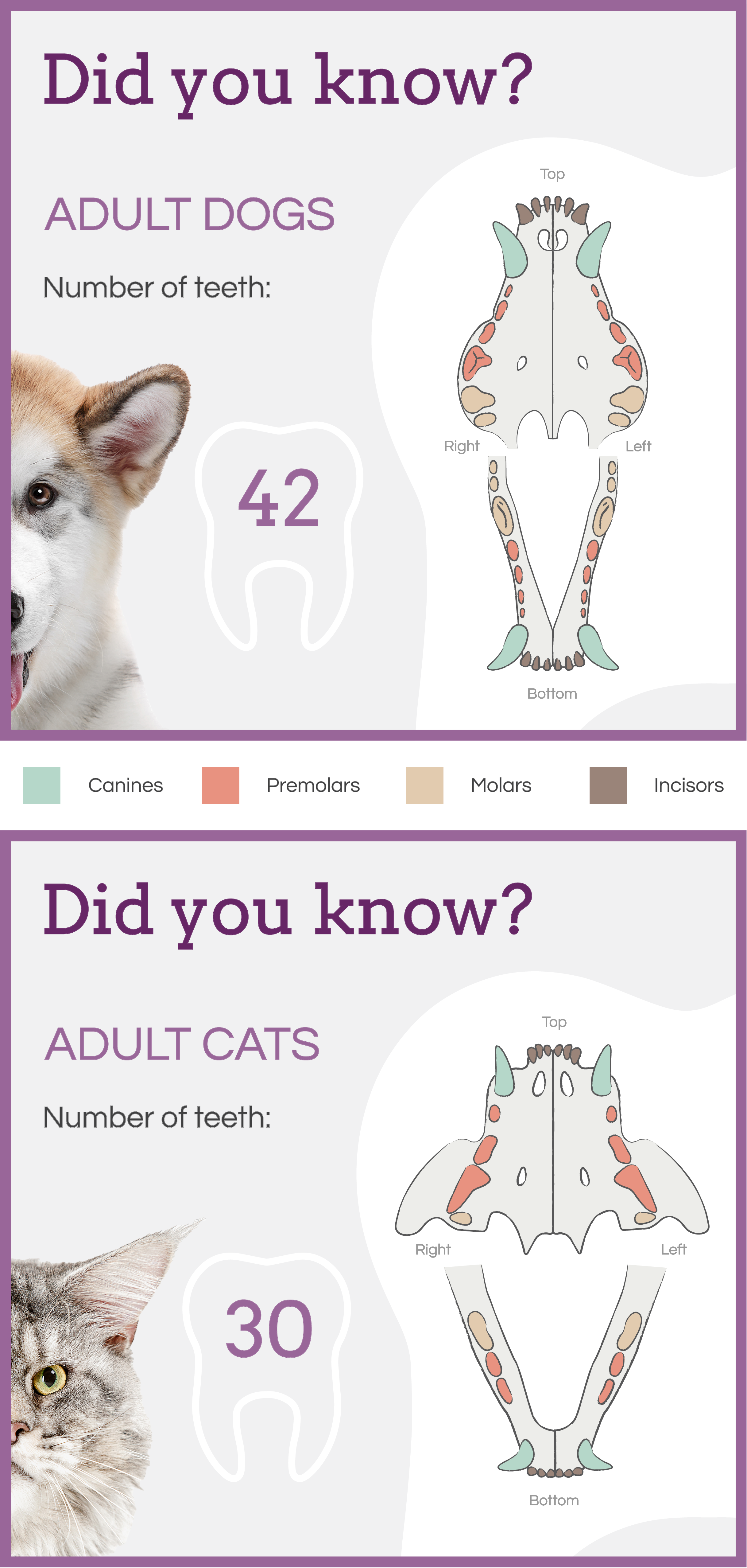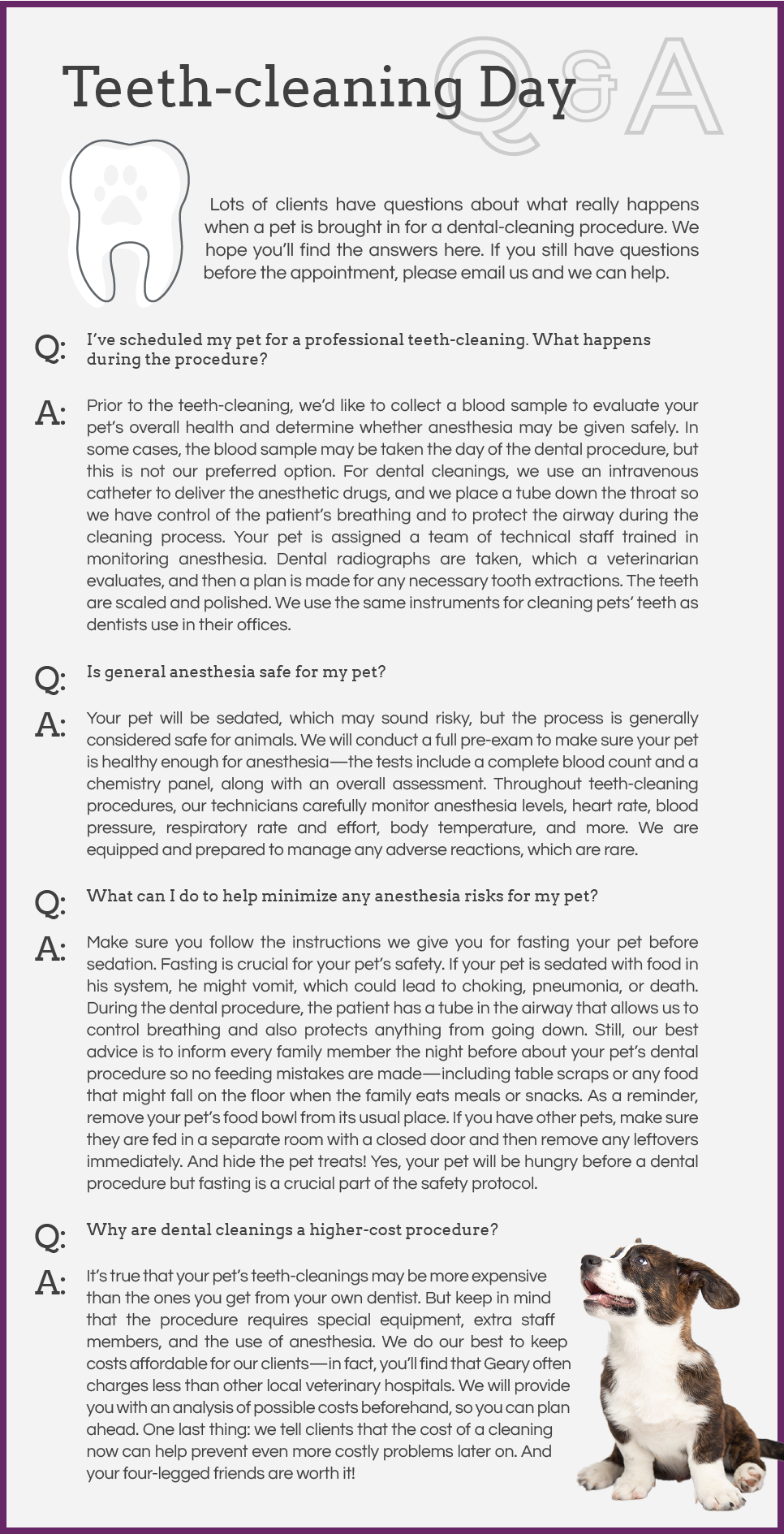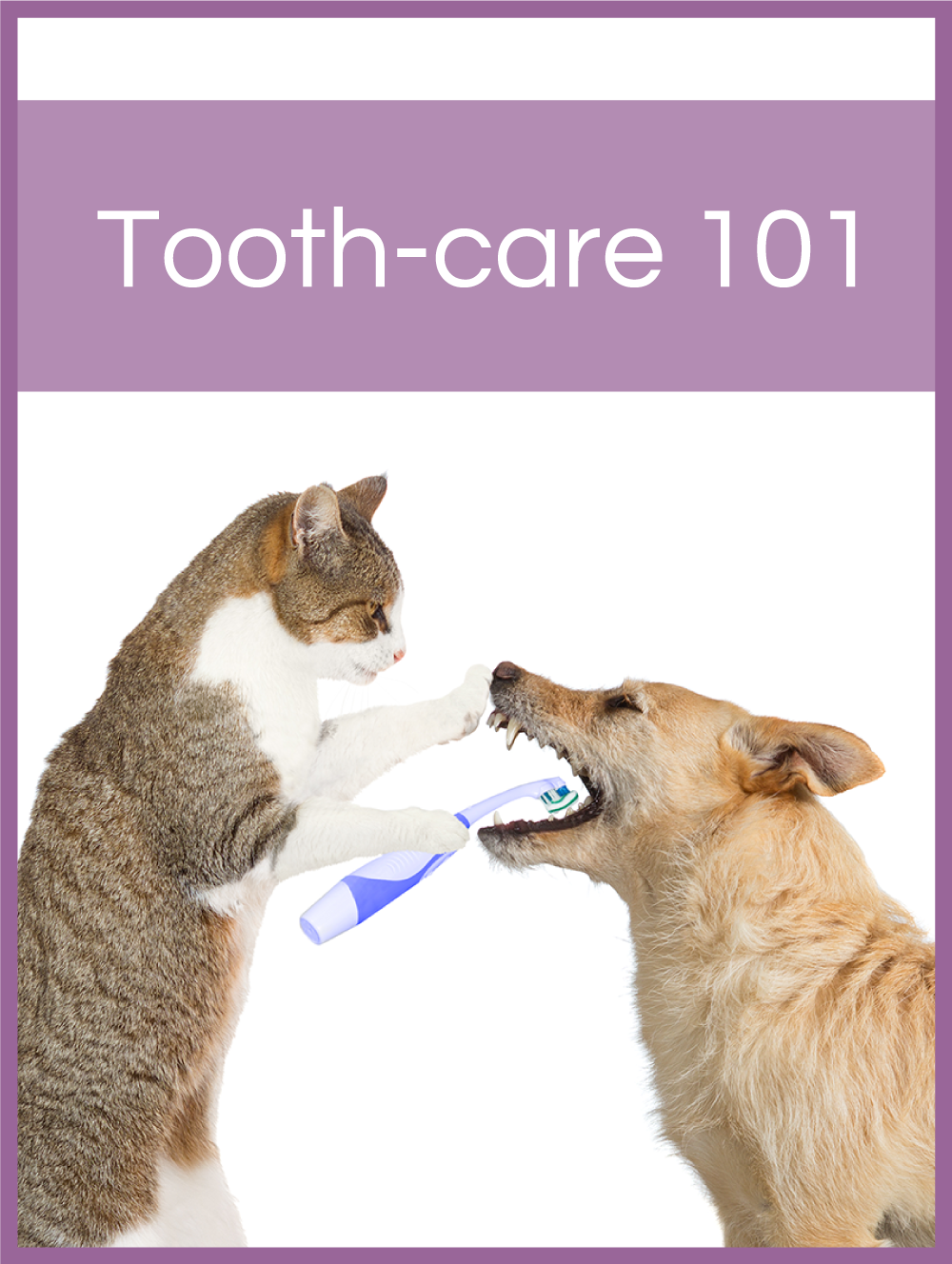
Can you imagine never brushing your teeth? Yuck! Good dental hygiene is essential to human health. But guess what? It’s just as essential for your pet’s overall health. According to the American Veterinary Medical Association (AVMA), 80 percent of dogs and 70 percent of cats have some form of periodontal disease by the age of three.
The good news is, these pet problems are preventable with regular dental cleanings and professional checkups. It’s important to catch the signs of dental disease early, which can only happen during a teeth-cleaning and annual checkups with our veterinarians. We’ll keep an eye on your pets’ teeth from the kitten/puppy years, throughout adulthood, and into the senior years.
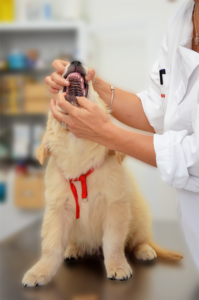
If your pet has missed annual evaluations and cleanings, don’t despair. Come see us, and we’ll take a look at what’s going on in your dog’s or cat’s mouth. Be sure to make an appointment if you notice the following signs in your pets:
BAD BREATH
A strong odor may suggest digestive problems or a dental condition
REDNESS OF THE GUMS
Swollen gums can lead to gum disease, an inability to eat, or tooth loss
LOOSE, DISCOLORED, OR BROKEN TEETH
TENDERNESS AROUND THE MOUTH OR TEETH
EXCESSIVE DROOLING, PAWING AT THE MOUTH AREA
BLEEDING FROM THE MOUTH
DIFFICULTY CHEWING FOOD
LOSS OF APPETITE/POOR APPETITE
WEIGHT LOSS
Periodontal disease starts with plaque on the teeth, just as it does in humans. Plaque is a bacterial film that attaches to the teeth if not brushed away and may eventually form a hard, rough substance called tarter—again, just like in humans—which then allows more plaque to accumulate. Spreading plaque leads to gingivitis, or gum inflammation, which causes the gums to swell and possibly bleed.

What veterinarians worry about is the plaque and tarter that may develop below an animal’s gum line, where the eye can’t see. Sometimes, this build-up leads to an infection (and/or an abscess) around the roots of the teeth. What happens next is painful for your four-legged friend: in the final stages of periodontal disease, tissues around the tooth are destroyed, the bony socket holding the tooth starts to erode, and then the tooth becomes loose.

You know from your own experience how painful it can be just to have a canker sore, a small cut in your mouth, or even a tooth infection—imagine what a pet with dental problems goes through each day. Dogs and cats are very good at hiding their tooth pain, continuing to eat and drink even when it hurts. If in pain, your pet will likely swallow the food whole and you may not realize that something is wrong.
Our animals can’t tell us in words where it hurts. This is why it’s so important for pet owners to be aware of dental issues and to make tooth-care an everyday routine. You can practice good dental habits with your pets at home. Follow these “Geary-Approved” tooth-care tips.
Dr. Hamilton’s Handy Guide for Brushing Your Dog’s Teeth
DO IT DAILY
Veterinary Dentists suggest brushing your dog’s teeth every day but if that’s not possible for you and your pup, then aim for three to four times per week.

USE THE RIGHT TOOLS
Toothbrushes for humans work just as well on dogs, but choose a soft-bristled brush in a size that fits your dog’s mouth. You can find canine toothbrushes that are angled and have a longer handle, if you prefer. Fingertip-style toothbrushes are also available for pets. See what works best for you both.
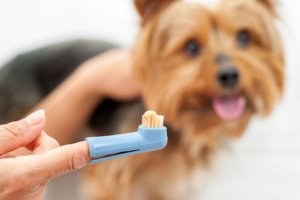
CHOOSE TASTY TOOTHPASTE
Canine toothpastes are safe for your dog to swallow and don’t contain the harsh detergents used in human formulas. Plus, canine toothpastes come in special flavors like poultry (yum?). You can also find products such as plaque-removing gels or doggie mouth wipes that allow you to swipe away bacteria and food particles. These are fine for days when you’re too busy for a full tooth-brushing.
MAKE IT POSITIVE!
Believe it or not, you can teach your dog to enjoy tooth-care. Start by gently handling your dog’s muzzle and mouth, using treats as reinforcers. For example, rub a little peanut butter on your dog’s gums or put some nonfat yogurt on your fingers as you move your dog’s lips aside to reach the teeth. Choose a quiet, private area of your home so your dog stays calmer. Give him time to sniff and lick the toothbrush and toothpaste. There’s no rush.

BRUSH THOROUGHLY
A circular brushing motion is the most effective. Make sure to ease back your dog’s lips so you can reach all the teeth. Reapply toothpaste as needed, if your dog licks it away. Remember to brush along the gum line. If you can’t get to the insides of your dog’s teeth, that’s okay. Most periodontal disease occurs on the outside of the teeth, where the lips and cheeks touch.
REWARD, REWARD, REWARD!
Your dog will feel better about teeth-brushing time if you offer praise, pats, and affection throughout. End each session with treats and play so your dog thinks of dental care as something positive.
BE A SMART SHOPPER
Many dog owners ask me about dental treats designed to clean dogs’ teeth. These treats can be helpful but aren’t a substitute for good old-fashioned teeth-brushing. Look for products approved by the Veterinary Oral Health Council (VOHC)®. Their stamp of approval means they meet teeth-cleaning protocols. Such products can help reduce unwanted plaque build-up but don’t replace the need to brush.
For a list of VOHC® approved products for dogs and cats, click below!
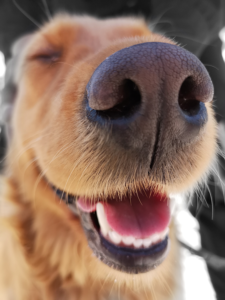
Dr. Weiss's Cat-Friendly Tips for Tooth-care
At one point, I had five cats living with me. Some of my clients have even more! That’s a lot of cat teeth to take care of. When I ask clients of Geary Veterinary Hospital if they brush their cats’ teeth, many look at me incredulously or burst out laughing. They say, “Touch my cat’s mouth? You’ve got to be kidding!” But no, I’m quite serious. Many cats come to the vet with dental problems that are preventable. Cat owners think kitties won’t allow their teeth to be brushed—and in some cases, that’s true. But with a lot of patience, you can help your cat tolerate tooth-care.
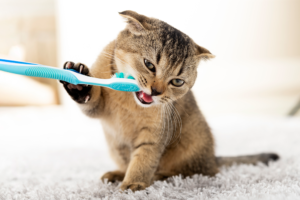
start with a checkup
Come to Geary for a basic dental exam and see if your cat needs a professional teeth-cleaning. Once you have a clean slate, you can start a home tooth-care routine.
choose your tools
Cat toothbrushes are smaller and have softer bristles than human toothbrushes. You may also choose a fingertip toothbrush. Look for toothpaste brands that are specially formulated for felines.
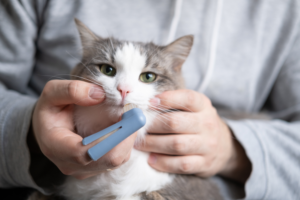
use a slow, gentle approach
Chances are, your cat will see a toothbrush as a toy or a threat. This is why patience is key. To get an idea of how your cat feels about being touched in the mouth area, wait for a time when the two of you are calmly cuddling. Gently pull back your cat’s lip to get a look at the teeth. Touch a tooth, and then wait for a reaction. You may find that your cat doesn’t mind this touching. If your cat seems uncomfortable, resume cuddling or let her go off on her own. You can gradually increase the contact with your cat’s mouth through this process of touching the teeth or gums. See if your kitty allows you to massage her gums with your finger.
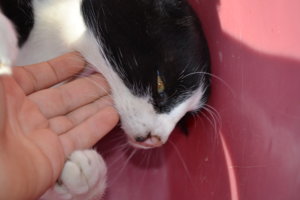
introduce the brush
Whether you choose a toothbrush or a fingertip brush, work up to using the tool gradually. Brush a couple of teeth. Done. The next day, brush a couple more. Done. Make sure cuddling and soothing are a part of the process. Over a period of time, you may get to the point where you’re able to brush your cat’s full mouth twice or more per week. Keep the sessions short and positive: no scolding or rough handling. If your cat truly hates the process, try wiping her teeth with a feline dental wipe or a gauze pad dipped in water.

BUY DENTAL TOYS AND TREATS
At Geary, we have recommendations for cat toys that have enzymes to help reduce plaque. You can choose treats and products approved by the Veterinary Oral Health Council (VOHC). Recently, bacteria-killing oral rinses have been developed for cats that refuse to let their owners directly clean the teeth. Call us!
FINISH WITH PLAY
Your cat might have some pent-up energy after a teeth-brushing session. Reward your kitty with play—or treats—so you end on a positive note.
Professional Teeth Cleaning
For most pet owners, making tooth-care an everyday routine is easier said than done. Practicing good dental habits with your pet(s) can be a challenge, let alone ones that are comparable to our own. We get it! The good news is pets can get their teeth professionally cleaned – just like humans! Dental procedures, like the ones we perform at Geary, are important in combating (and preventing) dental disease; helping your furry friend to live a happy, healthy, and pain-free life!
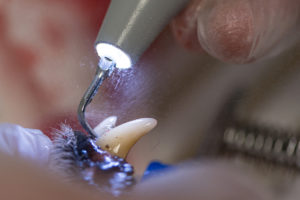
Questions? We have answers!
We provided answers to our most frequently asked questions in Teeth-cleaning Day Q & A – see below!

